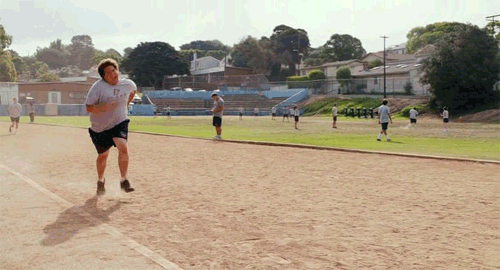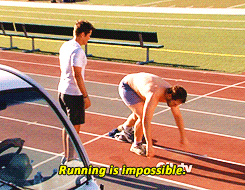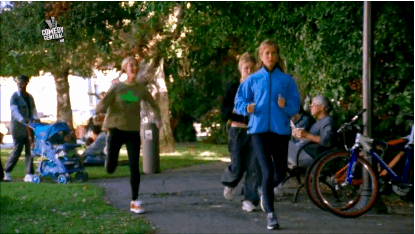DURING THE MINI heat-wave that hit Ireland this week, it was hard not to notice the growing number of people abandoning the treadmill for a run outdoors.
But if you are new to running, the thought of joining all those on the roads can seem intimidating.
Worse still, once you have made the decision to start running — it’s easy to make a series of mistakes that could put you off it for life.
But don’t worry, we’re here to help. Here is a list of some of the most common running mistakes and how you can avoid them.
8. Wrong Shoes
This seems like a no-brainer but a lot of people don’t realise how important a good pair of running shoes are. If you try to launch your running career in an old pair of runners, converse or vans you should expect some discomfort and possibly injury. There is nothing quite like blisters to make you lose your enthusiasm for running.
The answer is simple. Invest in a good quality pair of running shoes. There seems to be a misconception that running shoes cost a fortune but there are plenty of affordable options available.
7. Too much too soon
One of the biggest mistakes new runners make is trying to do too much too soon. They mistakenly think “more is better” when it comes to running. Enthusiasm is great but if you think you can go from 0 to 10k in one day, you will either hurt yourself or lose interest very quickly.
You need to build up a mileage base before increasing the distance, intensity and frequency of your runs. Think about starting with walking first and then progressing to a run/walk to slowly build yourself up.
Pay attention to aches and pains. If they are getting worse as you run, it might be time to call it a day. Make sure you’re giving yourself at least one day off exercise a week.
6. Technique
While running is one of the easiest and simplest sports to get involved in, it is easy to pick up bad habits. One of the most common injury-causing mistakes is something called overstriding. This is where beginners think that taking a bigger stride as you run makes you cover a greater distance faster. The reality is that stretching your foot out too far and landing on your front heel in not good for your joints, and can lead to injuries such as shin splints.
Focus on landing mid-sole, with your foot directly underneath your body with every step. Also, don’t swing your arms too much. Wildly swinging your arms not only makes you look silly but needlessly wastes energy.
5. Make sure you drink enough water
Many runners underestimate how much fluid they lose during runs and don’t drink enough because they’re worried about stitches. Others get so caught up in pushing themselves, they just forget to drink.
This can lead to headaches, dizziness and nausea.
Make sure you have a drink with you when you exercise, and hydrate before and after your run. Like too much of anything, it’s not good for you to overload yourself with water either.
The colour of your urine is a good indicator of your hydration levels. If your urine is a dark yellow colour after your run, you haven’t had enough fluids.
4. The Wrong Fuel
What and when you eat before, during and after your run has a huge effect on your performance and recovery. A lot of people don’t seem to realise that pints, a curry chip and a fry the next morning is not the ideal preparation for a run.
The best thing you can do is have a light snack an hour or two before you run. Cereal, bananas, energy bars and anything else that is high in carbs but low in fat would be perfect.
3. Pick a goal
No matter how committed you are at the beginning, it is very easy to lose interest in running if you haven’t set yourself a goal. You need to have clearly defined target to aim for.
Pick a distance like five or 10k that you want to build up to slowly and then choose a plan to get there. Set yourself a certain goal every week and keep building until you’ve reached your target. Then set another one. If you have no reason to push yourself, then you won’t.
2. Stretching
Running can be a very physically demanding sport. If you forget to warm up properly, cool down or stretch, you often pay the price. You can’t just walk out the door and burst into a sprint. You need to warm up with a few stretches, then begin a jog or brisk walk before building up to a faster pace.
The same can be said for after your run. Your body needs to cool down gradually. If you do some stretches, it will go along way in keeping your muscles from getting sore. We all hate waking up the next day after exercise and being unable to move without pain.
Some static stretching will keep the muscles flexible and limit stiffness.
1. Pacing
The biggest mistake every beginner makes is pacing themselves. They tear away like Usain Bolt and half way through their run, they can’t go on. Take your time.
A good way to judge is through conversation. If you’re running with a friend and you’re able to chat comfortably then you aren’t running quick enough. If you’re a wheezing mess that can’t utter a single word, you may be going too fast.
Learning to judge pace takes time, don’t rush yourself. Don’t compare yourself to other people who are boasting about how far they can run or a friend who doesn’t seem to tire as fast as you do.
Remember that every runner was a beginner once.





